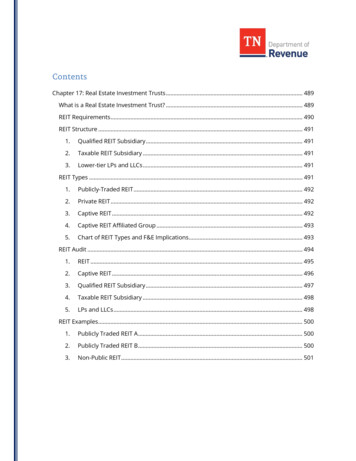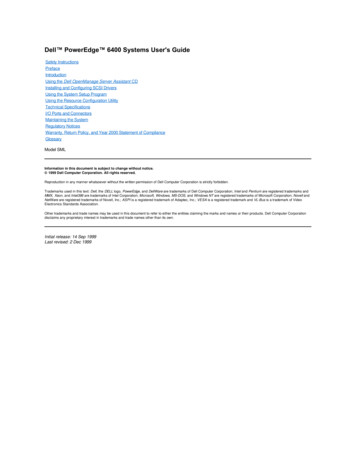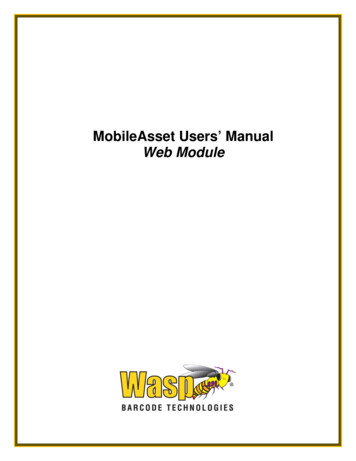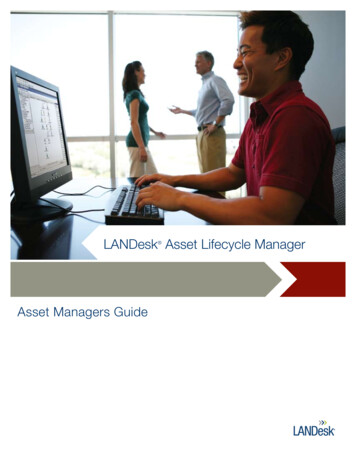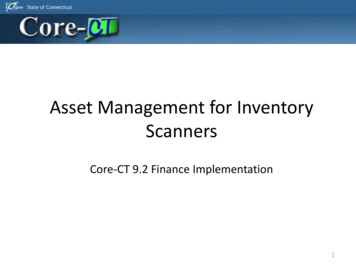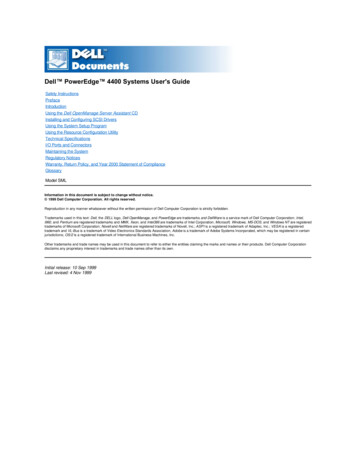
Transcription
GUNDERSON PALMER GOODSELL & NELSON, LLPAssurant Building 440 Mt. Rushmore Road Rapid City, SD 57709-8045Telephone: 605-342-1078 FAX: 605-342-9503Website: www.gundersonpalmer.comASSET PROTECTION TRUSTS ARRIVE IN SOUTH DAKOTAA Legal Bulletinby: Thomas E. SimmonsOn March 3, of last year, Governor Mike Rounds signed into law “An Act to AuthorizeQualified Dispositions in Trust” after the bill had unanimously passed both the SouthDakota Senate and House.This technical-sounding Act is a bombshell, yet it has hardly generated a whisper ofinterest or commentary by the media in South Dakota thus far. The Act became effectiveon July 1, 2005. Individuals now have the opportunity, for the first time, to create selfsettled spendthrift trusts in South Dakota. Self-settled trusts which contain enforceablecreditor protections are often referred to as domestic asset protection trusts (or “DAPTs”for short).“ALASKA TRUSTS” FOR SOUTH DAKOTANS (AND OTHERS TOO)The idea of a self-funded trust with creditor protections was first enacted in offshorejurisdictions beginning in the 1980s. These trusts, often venued in exotic locations such asthe Bahamas and the Cook Islands, sometimes suffered in the courts because of perceivedabuses.The first “domestic” jurisdiction to pass authorization for self-settled spendthrift trusts wasAlaska in 1997. Since then, Nevada, Delaware, Oklahoma, Colorado and a few otherstates have passed similar legislation.To qualify as a DAPT, the trust must (1) expressly incorporate South Dakota law; (2) haveat least one South Dakota trustee; and (3) be irrevocable.There are no limits to the amount of funds or property which can be transferred to a SouthDakota DAPT. There is no requirement that the grantor of the trust be a South Dakotaresident, nor that any property of the trust be located in our state. Thus, it is anticipatedthat South Dakota DAPTs will become popular with residents from other states wishing totake advantage of our favorable trust laws and state taxation.
HOW MUCH CONTROL AND ENJOYMENT CAN BE RETAINED?The South Dakota Act permits the individual creating the trust to retain the followingrights: Veto power over distributions; Income rights to trust property; Rights to 5% of the principal balance of trust property annually; Additional rights to principal in the trustee’s discretion; and The power to appoint to whom trust assets are distributed upon the grantor’sdeath (with certain minor limitations).LIMITATIONSThe South Dakota Act carves out two major exceptions to the creditor protection benefitsof a DAPT: Creditors claiming child support, alimony, and divorce decrees of propertydivision are not protected; Claims for death, personal injury or property damage caused by the grantor onor before the date the trust is created are not protected; and As with all spendthrift trusts, once a distribution is actually made by the trusteeand received by the grantor/beneficiary, it becomes an asset which is no longerprotected from creditors.In addition, creditors will sometimes be able to bring a “fraudulent transfer” claimassociated with the funding of a DAPT. However, the South Dakota Act requires creditorsto meet a very high burden of proof to do so. If an individual’s financial situation sodeteriorates that bankruptcy is triggered, the 2005 amendments to the Bankruptcy Codeprovide for a ten year “look back” period for transfers to self-settled trusts if a creditor canprove that the trust was intended to defraud and hinder creditors.1There are additional limitations to the protections of a DAPT when state lines are crossed.Self-settled spendthrift trusts are considered to be against “public policy” in some states.111 U.S.C. section 548(e)(1)(A).2
Thus, if the trust owns assets in another state, the protections of South Dakota law may notbe recognized if a creditor brings an action to satisfy a judgment against assets outside ofSouth Dakota. Protections are at their highest when: The Trustee is truly independent of influence or control by the grantor; The Trust instrument scrupulously adheres to the requirements of SouthDakota law; The Trust is funded with assets located in South Dakota; Any lawsuit arises out of events in South Dakota occurring after the trust wascreated; and If bankruptcy is involved, ten years passes between the funding of the trust andthe filing of a bankruptcy petition.Individuals who are non-residents of South Dakota may avail themselves of the benefits ofSouth Dakota DAPT statutes. These individuals, however, are at higher risk to sister statejurisdictions who permit “trust busting” of DAPTs.2CASE STUDYDr. Blank3 is a 45-year-old South Dakota physician with a net worth of 530,000. He hasa 300,000 house with 30,000 in equity, a 200,000 IRA, 100,000 in savings and 200,000 in investments. Realizing that as a professional, with a higher exposure to risk interms of professional malpractice claims, he decides to form a South Dakota DAPT.Dr. Blank funds the trust with his 200,000 investment portfolio held at a respected localfinancial brokerage firm. He enjoys the income from his investments and retains rights toadditional amounts if the need should arise. Specifically, his trust provides that the trusteeshall distribute all the income and 5% of the principal to Dr. Blank every year. In addition,the trustee has the discretion to distribute unlimited amounts of additional principal to Dr.Blank if the trustee determines that Dr. Blank needs it. Dr. Blank retains the power to“veto” distributions to himself if he prefers to allow the trust investments to grow.2See David G. Shaftel and David H. Brundy, Domestic Asset Protection Trusts and the BankruptcyChallenge, 32 ESTATE PLANNING 5, 11 (May 2005).3This case study is fictional and illustrative only. No client confidential information is contained in thisbulletin.3
Eight years later, Dr. Blank is served with a summons, naming him as a defendant in alawsuit. The facts out of which the lawsuit arose occurred in South Dakota after Dr.Blank’s trust had been funded. Ultimately, despite the fact that Dr. Blank feels the claimto be frivolous, a jury awards the plaintiff a judgment in the amount of nearly half amillion dollars, for which there is no specific coverage in his various liability insurancepolicies.Dr. Blank is forced to file bankruptcy.4 His savings have been depleted to 75,000 fromlawyer fees and lost wages. He will lose the bulk of his remaining savings which will beused to partially satisfy the judgment creditor.Following bankruptcy, the judgment is discharged. Dr. Blank keeps his house as theequity is protected by South Dakota’s homestead exemption. He also keeps his IRA sincethat is an asset which, in many cases, can be exempted as well. The assets in his DAPTare also exempt from the reach of the judgment creditor.Although the lawsuit had a devastating effect on Dr. Blank’s savings, it left the remainderof his net worth intact.WHO SHOULD CONSIDER A DAPT?Individuals who should determine if a DAPT is right for them include: Those whose net worth exceeds several hundred thousand dollars; Those in higher risk profile professions; Those whose assets may be exposed to lawsuits;54DAPTs have protections outside the context of bankruptcy, but bankruptcy is the context in which theywould face their greatest test. Section 541(c)(2) of the Bankruptcy Code has been repeatedly held bybankruptcy courts to protect a traditional spendthrift trust, such as might be set up by a parent for a child(i.e., a “third party” spendthrift trust). There has yet to be published legal authority showing thatbankruptcy courts will honor the shield of a DAPT in the same manner as a traditional spendthrift trust.The 2005 amendments to the Bankruptcy Code which create a “10-year look-back” for assets transferredto self-settled spendthrift trusts, however, implicitly recognize the enforceability of these trusts.5Assets for South Dakota residents which carry a lower risk of seizure include 401(k)s up to 250,000, ahomestead not exceeding 30,000 in equity, annuity contracts up to 250 per month and life insurancepayable to a spouse/dependents up to 20,000. Federal law provides different protections. Interests inclosely-held entities such as LLCs or corporations are not immune to creditors, but less attractive tocreditors because of the limited remedies available. Assets with the highest exposure to risk wouldinclude real property and investments.4
Those who believe their assets are worth protecting.ADDITIONAL BELLS AND WHISTLESBecause South Dakota earlier repealed the “Rule Against Perpetuities” that previouslyprohibited trusts of an infinite duration, some individuals will likely pursue the option ofcombining the idea of a dynasty trust (which effectively escapes estate taxes at eachgeneration with generation-skipping transfer tax provisions) with a DAPT. When a DAPTis used in this way, the savings in estate tax is icing on the cake of a solid asset protectionstrategy.CREATING A DAPTFlexibility is an exciting component of these trusts, and several different variations andtypes of trusts will be available to meet various objectives.ThomasE. Simmons practices inpcahoona@gpgnlaw.comthe areas of Elder Law, RealProperty, Estates and Nonprofits.tsimmons@gpgnlaw.comThe information in this bulletin should not be interpreted as legal advice.No one legal rule can be applied to all individuals or situations.General information is provided here. Always consult an attorney for legal consultation.Pursuant to IRS Circular 230, these materials are not intended or written to be usedand cannot be used by any taxpayer for the purpose of avoiding tax penalties thatmay be imposed on the taxpayer; taxpayers should seek advice based upon theirparticular circumstances from independent tax advisors.5
GUNDERSON PALMER GOODSELL & NELSON, LLP Assurant Building 440 Mt. Rushmore Road Rapid City, SD 57709-8045 Telephone: 605-342-1078 FAX: 605-342-9503 Website: www.gundersonpalmer.com
